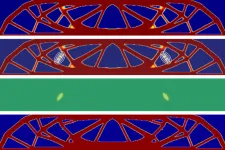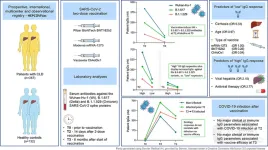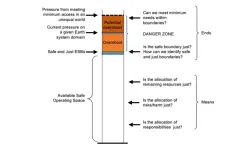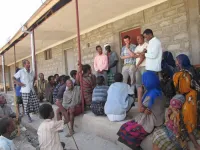(Press-News.org) Modern fabrication tools such as 3D printers can make structural materials in shapes that would have been difficult or impossible using conventional tools. Meanwhile, new generative design systems can take great advantage of this flexibility to create innovative designs for parts of a new building, car, or virtually any other device.
But such “black box” automated systems often fall short of producing designs that are fully optimized for their purpose, such as providing the greatest strength in proportion to weight or minimizing the amount of material needed to support a given load. Fully manual design, on the other hand, is time-consuming and labor-intensive.
Now, researchers at MIT have found a way to achieve some of the best of both of these approaches. They used an automated design system but stopped the process periodically to allow human engineers to evaluate the work in progress and make tweaks or adjustments before letting the computer resume its design process. Introducing a few of these iterations produced results that performed better than those designed by the automated system alone, and the process was completed more quickly compared to the fully manual approach.
The results are reported this week in the journal Structural and Multidisciplinary Optimization, in a paper by MIT doctoral student Dat Ha and assistant professor of civil and environmental engineering Josephine Carstensen.
The basic approach can be applied to a broad range of scales and applications, Carstensen explains, for the design of everything from biomedical devices to nanoscale materials to structural support members of a skyscraper. Already, automated design systems have found many applications. “If we can make things in a better way, if we can make whatever we want, why not make it better?” she asks.
“It’s a way to take advantage of how we can make things in much more complex ways than we could in the past,” says Ha, adding that automated design systems have already begun to be widely used over the last decade in automotive and aerospace industries, where reducing weight while maintaining structural strength is a key need.
“You can take a lot of weight out of components, and in these two industries, everything is driven by weight,” he says. In some cases, such as internal components that aren’t visible, appearance is irrelevant, but for other structures aesthetics may be important as well. The new system makes it possible to optimize designs for visual as well as mechanical properties, and in such decisions the human touch is essential.
As a demonstration of their process in action, the researchers designed a number of structural load-bearing beams, such as might be used in a building or a bridge. In their iterations, they saw that the design has an area that could fail prematurely, so they selected that feature and required the program to address it. The computer system then revised the design accordingly, removing the highlighted strut and strengthening some other struts to compensate, and leading to an improved final design.
The process, which they call Human-Informed Topology Optimization, begins by setting out the needed specifications — for example, a beam needs to be this length, supported on two points at its ends, and must support this much of a load. “As we’re seeing the structure evolve” on the computer screen in response to initial specification, Carstensen says, “we interrupt the design and ask the user to judge it. The user can select, say, ‘I’m not a fan of this region, I’d like you to beef up or beef down this feature size requirement.’ And then the algorithm takes into account the user input.”
While the result is not as ideal as what might be produced by a fully rigorous yet significantly slower design algorithm that considers the underlying physics, she says it can be much better than a result generated by a rapid automated design system alone. “You don’t get something that’s quite as good, but that was not necessarily the goal. What we can show is that instead of using several hours to get something, we can use 10 minutes and get something much better than where we started off.”
The system can be used to optimize a design based on any desired properties, not just strength and weight. For example, it can be used to minimize fracture or buckling, or to reduce stresses in the material by softening corners.
Carstensen says, “We’re not looking to replace the seven-hour solution. If you have all the time and all the resources in the world, obviously you can run these and it’s going to give you the best solution.” But for many situations, such as designing replacement parts for equipment in a war zone or a disaster-relief area with limited computational power available, “then this kind of solution that catered directly to your needs would prevail.”
Similarly, for smaller companies manufacturing equipment in essentially “mom and pop” businesses, such a simplified system might be just the ticket. The new system they developed is not only simple and efficient to run on smaller computers, but it also requires far less training to produce useful results, Carstensen says. A basic two-dimensional version of the software, suitable for designing basic beams and structural parts, is freely available now online, she says, as the team continues to develop a full 3D version.
“By integrating engineering ‘intuition’ (or engineering ‘judgement’) into a rigorous yet computationally efficient topology optimization process, the human engineer is offered the possibility of guiding the creation of optimal structural configurations in a way that was not available to us before,” he adds. “Her findings have the potential to change the way engineers tackle ‘day-to-day’ design tasks.”
###
Written by David Chandler, MIT News Office
END
Integrating humans with AI in structural design
A process that seeks feedback from human specialists proves more effective at optimization that automated systems working alone.
2023-03-02
ELSE PRESS RELEASES FROM THIS DATE:
Foundation for anesthesia education and research establishes endowed NAM fellowship
2023-03-02
CHICAGO – The Foundation for Anesthesia Education and Research (FAER) announced it has established an endowed National Academy of Medicine (NAM) fellowship to provide early-career anesthesiology scholars with the opportunity to experience and participate in committee, workshop, and roundtable activities of NAM and the National Academy of Sciences (NAS).
Offering a robust catalogue of research grants and programs for early-career anesthesiology investigators, FAER – an American Society of Anesthesiologists’ foundation – is always exploring new avenues of support for up-and-coming researchers. The NAM Fellowship Program was recognized as one such ...
Liver cirrhosis is associated with a lower immune response to COVID-19 vaccines but not with reduced vaccine efficacy
2023-03-02
Amsterdam, March 2, 2023 – The overall responsiveness of patients with chronic liver disease (CLD) to COVID-19 vaccines has been shown to be decreased in patients with cirrhosis. A new prospective study in JHEP Reports, published by Elsevier, now shows that this lower response is observed up to six months following two-dose COVID-19 mRNA vaccination, but it does not reduce vaccine efficacy.
In this prospective study, more than 350 patients with CLD were recruited in clinical centers from Austria, Belgium, Italy, Portugal, Romania, and Spain. Cirrhosis, alongside age and vaccine ...
Human norovirus GII.4 exploits unexpected entry mechanism to cause gastroenteritis
2023-03-02
Human noroviruses are the leading cause of acute gastroenteritis worldwide, a major global health problem for which there are no specific treatments or vaccines. Understanding the first phase of infection – the process the virus follows to invade cells – is a decisive step in the development of effective preventive and therapeutic strategies. A team led by researchers at Baylor College of Medicine is making strides in that direction.
The researchers report in the journal Nature Communications that the globally dominant human norovirus GII.4 strain invades gastrointestinal cells via an unexpected mechanism. The viral strategy involves interactions ...
AI predicts cancer patient survival by reading doctor's notes
2023-03-02
A team of researchers from the University of British Columbia and BC Cancer have developed an artificial intelligence (AI) model that predicts cancer patient survival more accurately and with more readily available data than previous tools.
The model uses natural language processing (NLP) – a branch of AI that understands complex human language – to analyze oncologist notes following a patient’s initial consultation visit—the first step in the cancer journey after diagnosis. By identifying characteristics unique to each ...
For older adults, every 500 additional steps taken daily associated with lower heart risk
2023-03-02
Research Highlights:
A study of people ages 70 and older found walking an additional 500 steps per day, or an additional quarter mile of walking, was associated with a 14% lower risk of heart disease, stroke or heart failure.
Compared to adults who took less than 2,000 steps per day, adults who took about 4,500 steps per day had a 77% lower observed risk of experiencing a cardiovascular event.
Only about 3.5% of participants who took around 4,500 steps per day had a cardiovascular event, compared to 11.5% of those who took less than 2,000 steps per day, over the 3.5-year follow-up period.
Embargoed until 10:45 a.m. CT/11:45 a.m. ET, ...
American Society for Metabolic and Bariatric Surgery supports new clinical guidance on treatment of obesity in children and teens
2023-03-02
The American Society for Metabolic and Bariatric Surgery (ASMBS) fully supports the new “Clinical Practice Guideline for the Evaluation and Treatment of Children and Adolescents With Obesity” issued from the American Academy of Pediatrics (AAP) calling for earlier and more intensive treatment of obesity in children and teens. Published in the journal Pediatrics in February, this is the first comprehensive guideline on obesity in 15 years from the AAP, the largest professional association of pediatricians in the U.S.
According to AAP, more evidence ...
Many firearm owners in the U.S. store at least one gun unlocked, fearing an emergency
2023-03-02
Most firearm owners keep at least one firearm unlocked, with some viewing gun locks as an unnecessary obstacle to quick access in an emergency, according to a Rutgers study. But when they do lock their firearms, Rutgers researchers found that firearm owners are most likely to use gun safes.
In a study published in JAMA Network Open and funded by the Defense Health Agency, researchers surveyed a national sample of 2,152 English-speaking adult firearm owners, asking them what locking devices they used and why.
Unlike previous studies, participants were presented with both words and images describing each ...
To ensure a safe and just future for people, nature and the planet, Earth System Boundaries must include justice, researchers find
2023-03-02
In a new study published in Nature Sustainability an international team of scientists from the Earth Commission, convened by Future Earth, investigates how global biophysical boundaries need to be adjusted to ensure a safe and just future for people, nature and the planet. The Earth Commission is the scientific cornerstone of the Global Commons Alliance
This new framework integrates methods to reduce harm to people, increase access to resources, address tradeoffs, and challenge powerful interests whilst addressing inequality between generations and between humans and nature ...
Genomic study of indigenous Africans paints complex picture of human origins and local adaptation
2023-03-02
Africa, where humans first evolved, today remains a place of remarkable diversity. Diving into that variation, a new analysis of 180 indigenous Africans from a dozen ethnically, culturally, geographically, and linguistically varied populations by an international scientific team offers new insights into human history and biology, and may inform precision medicine approaches of the future.
The work clarifies human migration histories, both historical and more recent, and provides genetic evidence of adaptation to local environments, ...
Energy: More than two million citizens power Europe’s renewable energy transition
2023-03-02
More than two million citizens across 30 European countries have been involved in thousands of projects and initiatives as part of efforts to transition to renewable energy, according to an analysis published in Scientific Reports. With investments ranging between 6.2 and 11.3 billion Euros, these findings highlight the important role of collective action in the decarbonisation of Europe.
The energy system in Europe is undergoing a significant transition towards renewables and decarbonisation. However, the contribution ...
LAST 30 PRESS RELEASES:
Making lighter work of calculating fluid and heat flow
Normalizing blood sugar can halve heart attack risk
Lowering blood sugar cuts heart attack risk in people with prediabetes
Study links genetic variants to risk of blinding eye disease in premature infants
Non-opioid ‘pain sponge’ therapy halts cartilage degeneration and relieves chronic pain
AI can pick up cultural values by mimicking how kids learn
China’s ecological redlines offer fast track to 30 x 30 global conservation goal
Invisible indoor threats: emerging household contaminants and their growing risks to human health
Adding antibody treatment to chemo boosts outcomes for children with rare cancer
Germline pathogenic variants among women without a history of breast cancer
Tanning beds triple melanoma risk, potentially causing broad DNA damage
Unique bond identified as key to viral infection speed
Indoor tanning makes youthful skin much older on a genetic level
Mouse model sheds new light on the causes and potential solutions to human GI problems linked to muscular dystrophy
The Journal of Nuclear Medicine ahead-of-print tip sheet: December 12, 2025
Smarter tools for peering into the microscopic world
Applications open for funding to conduct research in the Kinsey Institute archives
Global measure underestimates the severity of food insecurity
Child survivors of critical illness are missing out on timely follow up care
Risk-based vs annual breast cancer screening / the WISDOM randomized clinical trial
University of Toronto launches Electric Vehicle Innovation Ontario to accelerate advanced EV technologies and build Canada’s innovation advantage
Early relapse predicts poor outcomes in aggressive blood cancer
American College of Lifestyle Medicine applauds two CMS models aligned with lifestyle medicine practice and reimbursement
Clinical trial finds cannabis use not a barrier to quitting nicotine vaping
Supplemental nutrition assistance program policies and food insecurity
Switching immune cells to “night mode” could limit damage after a heart attack, study suggests
URI-based Global RIghts Project report spotlights continued troubling trends in worldwide inhumane treatment
Neutrophils are less aggressive at night, explaining why nighttime heart attacks cause less damage than daytime events
Menopausal hormone therapy may not pose breast cancer risk for women with BRCA mutations
Mobile health tool may improve quality of life for adolescent and young adult breast cancer survivors
[Press-News.org] Integrating humans with AI in structural designA process that seeks feedback from human specialists proves more effective at optimization that automated systems working alone.



